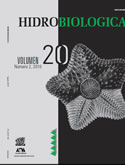Respiration, Excretion and Oxygen: Nitrogen Ratio of the Phyllosomes of the Red Spiny Lobster Panulirus interruptus
Keywords:
Red Spiny Lobster, early phyllosoma, respiration, excretion, metabolic rate.Abstract
The culture of the lobster Panulirus interruptus is limited due to the lack of knowledge that allow the completion of all larval stages. This work presents data on daytime and nightime oxygen consumption and ammonia excretion in phyllosoma I and II of the red lobster Panulirus interruptus reared in the lab at 21 °C and feeding with enriched Artemia nauplii. During starvation, the oxygen consumption by larvae phyllosoma dropped from 5.29 in the first hour to 3.54 mg O2 g-1h-1 after 14 h. The postabsorptive state was achieved after 13.5 h of starvation. This observation was taken into account to use starved larvae in our study. Oxygen consumption in the daytime was significantly higher than in the nightime in both larval stages. The levels of oxygen consumption (mg O2 g-1h-1) during daytime and nightime were: 4.28 and 3.66 in phyllosoma I and; 3.8 and 3.17 in phyllosoma II, respectively. There were no significant daytime/nightime differences of ammonia excretion: phyllosoma I excreted 0.011 to 0.095 mg NH4 g-1h-1; phyllosoma II excreted 0 to 0.65 mg NH4 g-1h-1. Oxygen consumption and ammonia excretion were significantly higher in phyllosoma I than in phyllosoma II. There were no significant differences between daytime and nightime The Oxygen-Nitrogen ratios of 59.1 to 422.4 obtained in both stages suggest a catabolism ranging from utilization of equal values of proteins and lipids to utilization of lipids and carbohydrates.Downloads
Downloads
Published
How to Cite
Issue
Section
License
Los autores/as que publiquen en esta revista aceptan las siguientes condiciones:
De acuerdo con la legislación de derechos de autor, HIDROBIOLÓGICA reconoce y respeta el derecho moral de los autores, así como la titularidad del derecho patrimonial, el cual será cedido a la revista para su difusión en acceso abierto.
Publicar en la revista HIDROBIOLÓGICA tiene un costo de recuperación de $500 pesos mexicanos por página en blanco y negro (aproximadamente 29 dólares americanos) y $1000 pesos por página a color (aproximadamente 58 dólares americanos).
Todos los textos publicados por HIDROBIOLÓGICA sin excepción se distribuyen amparados bajo la licencia Creative Commons 4.0Atribución-No Comercial (CC BY-NC 4.0 Internacional), que permite a terceros utilizar lo publicado siempre que mencionen la autoría del trabajo y a la primera publicación en esta revista.
Los autores/as pueden realizar otros acuerdos contractuales independientes y adicionales para la distribución no exclusiva de la versión del artículo publicado en HIDROBIOLÓGICA (por ejemplo incluirlo en un repositorio institucional o publicarlo en un libro) siempre que indiquen claramente que el trabajo se publicó por primera vez en HIDROBIOLÓGICA.
Para todo lo anterior, el o los autor(es) deben remitir el formato de Carta-Cesión de la Propiedad de los Derechos de la primera publicación debidamente requisitado y firmado por el autor(es). Este formato se puede enviar por correo electrónico en archivo pdf al correo: enlacerebvistahidrobiológica@gmail.com; rehb@xanum.uam.mx (Carta-Cesión de Propiedad de Derechos de Autor).
Esta obra está bajo una licencia de Creative Commons Reconocimiento-No Comercial 4.0 Internacional.


